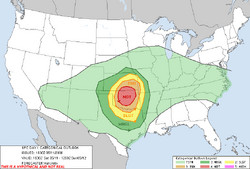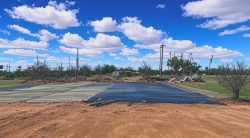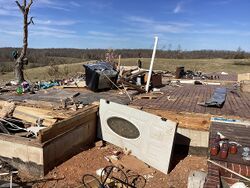Tornado outbreak of May 11-12, 2030
 The SPC's MODERATE Risk on May 11 | |
| Meteorological history | |
|---|---|
| Duration | 14 hours, 12 minutes |
| Tornado outbreak | |
| Tornadoes | 19 |
| Maximum rating | EF5 tornado |
|
| |
| Highest winds | Tornadic - 205 mph (330 km/h) (Moore, Oklahoma EF5 on May 11) |
| Overall effects | |
| Fatalities | 35+ |
| Injuries | 315+ |
| Damage | ~$2.1 billion (2025 USD) |
| Areas affected | Oklahoma, Kansas, Missouri |
| Power Outages | Unknown |
The Tornado outbreak of May 11–12, 2030, was a destructive and deadly tornado outbreak that affected portions of the Southern Plains and Lower Midwest, primarily impacting Oklahoma, Kansas, and Missouri. Over a span of 14 hours and 12 minutes, 19 tornadoes touched down across three states, including one rated EF5 on the Enhanced Fujita scale. The most catastrophic tornado of the outbreak occurred in Moore, Oklahoma, where an EF5 wedge tornado caused widespread devastation, resulting in at least 35 fatalities and over 315 injuries.
The outbreak unfolded in response to a powerful springtime low-pressure system interacting with a moist and unstable air mass over the central United States. The Storm Prediction Center issued a Moderate Risk for severe weather on May 11, citing a heightened potential for long-track, violent tornadoes. Tornadic supercells developed rapidly during the afternoon hours, particularly near the dryline–warm front triple point in central Oklahoma. While most tornadoes were weak to moderate in intensity, two were rated violent—an EF4 in El Reno and the aforementioned EF5 in Moore.
In total, the outbreak caused approximately $2.1 billion in damage (2030 USD), making it one of the costliest May outbreaks in recent U.S. history. Emergency declarations were issued in all three affected states, and widespread power outages, infrastructure failure, and search-and-rescue operations continued for days. The Moore tornado alone accounted for the vast majority of casualties and financial loss. The event reaffirmed the Southern Plains’ status as one of the most tornado-prone regions in the world and reignited national discussions about tornado resilience, shelter access, and building codes.
Meteorological synopsis
On May 11, a highly volatile environment developed across the Southern Plains as a strong mid- to upper-level trough exited the Desert Southwest and moved into the central United States. This synoptic setup was characterized by a rapidly deepening surface low near the Texas Panhandle, a warm front lifting into central Oklahoma, and a sharpening dryline trailing southward into Texas. This intersection formed a potent triple point configuration, ideal for tornadic supercell development.
Surface temperatures climbed to 86 °F with dewpoints around 73 °F, creating extremely unstable conditions across the risk zone. The thermodynamic profile included a surface-based CAPE of 4,456 J/kg and a 3-km CAPE of 123 J/kg. Lapse rates were steep, with 0–3 km lapse rates at 8.7 C/km and 3–6 km lapse rates at 7.4 C/km, suggesting deep, vigorous updraft potential. Storm-relative helicity was measured at 457 m²/s², while deep-layer shear and veering wind profiles were supportive of tornadic mesocyclones. Surface relative humidity was high at 83%, and 700–500 mb RH was 55%, suggesting ample moisture for storm maintenance despite modest precipitable water values (PWAT) of 0.4 inches.
The Storm Prediction Center issued a Moderate Risk across central and eastern Oklahoma and northern Texas, citing the potential for strong, long-track tornadoes. A Particularly Dangerous Situation (PDS) Tornado Watch was issued by 16:30 UTC, shortly before the first supercells began to develop. Discrete storms quickly organized into tornadic cells, producing multiple weak tornadoes early in the event, before intensifying into stronger systems. The EF5 tornado in Moore formed from one of these early afternoon storms, which intensified rapidly as it neared the Oklahoma City metro. Additional tornadoes, including an EF4 in El Reno, followed later in the evening as storms progressed eastward into Kansas and Missouri.
Confirmed tornadoes
| EFU | EF0 | EF1 | EF2 | EF3 | EF4 | EF5 | Total |
|---|---|---|---|---|---|---|---|
| 0 | 8 | 4 | 3 | 2 | 1 | 1 | 19 |
Moore, Oklahoma
 A well-built restaurant that suffered EF5 damage. | |
| Meteorological history | |
|---|---|
| Formed | May 11, 2030, 1:21 p.m. CDT (UTC-5:00) |
| Dissipated | May 11, 2030, 2:13 p.m. CDT (UTC-5:00) |
| Duration | 52 minutes |
| EF5 tornado | |
| on the Enhanced Fujita scale | |
| Highest winds | 205 mph (330 km/h) |
| Overall effects | |
| Casualties | 35+ fatalities, 315+ injuries |
The most violent tornado of the outbreak struck Moore, Oklahoma, on the afternoon of May 11, producing catastrophic EF5 damage across the city. It developed southwest of Newcastle at approximately 1:21 p.m. CDT and moved northeast, quickly intensifying into a large wedge tornado as it approached the Oklahoma City metro. The tornado reached a peak width of nearly 1 mile and remained on the ground for 15.1 miles before dissipating at 2:07 p.m. CDT near Lake Stanley Draper. Maximum estimated winds were recorded at 205 mph (330 km/h), with radar indicating a strong debris ball and high-end velocity couplet. The storm’s path closely mirrored those of the devastating EF5 tornadoes that impacted Moore in 1999 and 2013, passing through many of the same neighborhoods and subdivisions. Residential areas in southern and central Moore were particularly hard-hit, with entire blocks flattened and many homes swept completely from their foundations.
More than 2,000 homes and businesses were damaged or destroyed by the tornado. Numerous fatalities occurred in residential areas, particularly near Briarwood Elementary School and the Plaza Towers subdivision. While both schools sustained damage, classes were not in session due to the tornado striking on a Saturday, likely preventing further loss of life. Briarwood Elementary suffered partial roof failure and damage to multiple classrooms, while Plaza Towers Elementary — rebuilt after its 2013 destruction — endured significant roof and facade damage, though its reinforced structure remained standing. The tornado’s EF5 rating was assigned based on the total destruction of a well-engineered, anchor-bolted restaurant in southern Moore, the only damage indicator to exceed EF4 thresholds. Debris from the restaurant was scattered hundreds of yards, and anchoring systems were found ripped or sheared. Vehicles were thrown long distances, and several were wrapped around trees or shredded beyond recognition.
In total, the Moore tornado resulted in at least 35 fatalities and over 315 injuries, making it the deadliest single tornado of the 2030 outbreak and one of the deadliest in Oklahoma history since 2013. Emergency response teams described the scene in Moore as chaotic, with blocked roads, power outages, and overwhelmed communications infrastructure. The tornado knocked out power to tens of thousands of residents, ruptured gas lines, and temporarily disabled cell towers and 911 systems. Search and rescue efforts were hampered by debris piles that exceeded ten feet in some areas. Recovery of victims took days, with final identification of all deceased individuals not completed until nearly three weeks later. The National Weather Service and emergency managers praised the effectiveness of early warnings and weather radios, though the tornado’s speed and strength left little time for many to seek shelter. Estimated damage from the Moore tornado alone exceeded $2.1 billion, placing it among the costliest tornadoes in U.S. history. The event once again reignited discussion about tornado resilience, especially in Moore, which has now been struck by three EF5 tornadoes in just over three decades.
El Reno, Oklahoma
 A home suffering low-end EF4 damage near downtown El Reno. | |
| Meteorological history | |
|---|---|
| Formed | May 11, 2030, 2:58 p.m. CDT (UTC-5:00) |
| Dissipated | May 11, 2030, 3:41 p.m. CDT (UTC-5:00) |
| Duration | 43 minutes |
| EF4 tornado | |
| on the Enhanced Fujita scale | |
| Highest winds | 170 mph (270 km/h) |
| Overall effects | |
| Casualties | 8 fatalities, 38 injuries |
The second-deadliest tornado of the outbreak impacted El Reno, Oklahoma, during the late afternoon of May 11, 2030. Rated a high-end EF4, the tornado developed just south of Union City at approximately 2:58 p.m. CDT and moved northeast through central Canadian County, striking the core of El Reno before dissipating just after 3:41 p.m. CDT. The National Weather Service in Norman issued a Tornado Emergency for the city as the tornado approached, citing observed large and destructive tornado conditions. The tornado followed a 15-mile path and reached maximum sustained winds of 170 mph (270 km/h). The storm produced widespread destruction across urban, suburban, and rural zones and was the strongest tornado to hit the city since the 2013 El Reno tornado.
The tornado first touched down southwest of the city in rural farmland, where it caused EF2 to EF3 damage to agricultural structures and isolated homes. Numerous metal storage buildings and livestock facilities were obliterated, and a gas compressor station west of El Reno sustained direct impacts that forced temporary evacuations. As the tornado approached El Reno proper, it rapidly intensified into a large cone tornado, producing a visible debris cloud and radar-confirmed debris ball by 3:08 p.m. CDT. Upon reaching the downtown area, the tornado caused severe damage to homes, schools, and commercial buildings. Several residential subdivisions experienced near-complete destruction, including two-story brick homes that were reduced to foundations. The tornado crossed U.S. Route 81 and Interstate 40, where multiple vehicles were tossed from the highway. A pickup truck was lofted more than 500 feet and thrown into an overpass.
El Reno Regional Airport sustained significant damage as the tornado crossed its main runway. Several small aircraft were flipped or destroyed, and jet fuel tanks ignited in a brief flash fire, although no fatalities occurred at the airport. Additional damage was reported at a fire station, water treatment facility, and community center. Citywide water service was disrupted, and dozens of power poles were snapped across the city. Surveillance cameras captured dramatic footage of the tornado as it tore through industrial parks and parking lots, scattering vehicles and debris across open fields.
In total, the tornado killed 8 people and injured 38 others, with most casualties occurring in residential areas lacking storm shelters. Two individuals were killed in separate vehicle incidents along I-40, while another died after a commercial roof collapse. Of the injured, at least 12 were listed in critical condition during the first 24 hours. Search-and-rescue teams spent two days combing debris for survivors and victims. Emergency response in El Reno was bolstered by state aid and National Guard deployments, but debris and blocked roads hindered immediate access to some neighborhoods. The tornado caused extensive damage to both public infrastructure and private property, with total losses estimated in the hundreds of millions of dollars.
Impact
The tornado outbreak caused widespread destruction across Oklahoma, Kansas, and Missouri, with several intense and long-track tornadoes contributing to significant loss of life and property. Of the 19 tornadoes confirmed during the event, five were particularly notable for their strength, duration, and impacts.
The most catastrophic tornado of the outbreak occurred in Moore, Oklahoma, where an EF5 tornado struck densely populated neighborhoods. The tornado carved a 15.1-mile path through Cleveland and Oklahoma counties, killing at least 35 people and injuring more than 315 others. With peak winds estimated at 205 mph (330 km/h), the tornado completely destroyed thousands of structures, including homes, schools, and businesses, and caused an estimated $2.1 billion in damage. This was the third EF5 tornado to strike Moore in just over 30 years, following similar disasters in 1999 and 2013.
Another violent tornado touched down in El Reno, Oklahoma, later rated EF4. The tornado tore through industrial areas and residential neighborhoods on the southern edge of the city, leveling several metal warehouses and severely damaging homes. Multiple injuries were reported, and damage totals exceeded several hundred million dollars. Wind speeds were estimated to have peaked between 170–180 mph. Though less deadly than the Moore tornado, the El Reno EF4 was the second most powerful of the outbreak and caused considerable infrastructure disruption.
In Tulsa, Oklahoma, a large EF3 tornado impacted the city’s western suburbs during the early evening hours. The tornado damaged dozens of homes and businesses and downed hundreds of trees and power lines. Emergency officials noted that early warning systems helped reduce injuries, though several people were hospitalized, and numerous homes were declared uninhabitable. The tornado’s track spanned several miles across the metro, damaging multiple shopping centers and apartment complexes.
To the north, an EF3 tornado affected the Ponca City area in north-central Oklahoma. The tornado remained on the ground for over 20 minutes and caused heavy damage to agricultural structures and rural homes. Several large barns were completely destroyed, and debris was thrown across highways. Despite the intensity of the storm, no fatalities were reported, though a handful of residents were treated for storm-related injuries.
Farther east, one EF2 tornado tracked across southeastern Kansas before crossing into southwestern Missouri, narrowly missing the city of Joplin. The tornado damaged homes, power lines, and outbuildings in Jasper County, Missouri, particularly in rural communities west of Joplin. Several injuries occurred as mobile homes were overturned and trees fell onto occupied structures. Local emergency services referenced the 2011 Joplin tornado in press briefings, expressing relief that the storm had remained west of the urban center.
Overall, the outbreak killed at least 35 people and injured over 315. The vast majority of casualties occurred in Moore, though tornado-related injuries were reported in at least four counties across three states. Emergency declarations were issued at both state and federal levels, and thousands of first responders were deployed throughout the region to assist with rescue, damage assessment, and recovery.
Aftermath
In the days following the outbreak, state and federal emergency management agencies—including FEMA and the Oklahoma National Guard—deployed personnel to aid in recovery efforts. Search and rescue missions continued for over 72 hours in the hardest-hit areas. Dozens of shelters were opened to house displaced families, and mutual aid was sent from neighboring states to assist with food distribution, medical triage, and debris removal.
Due to the scope and severity of the Moore tornado, national attention was quickly drawn to the event. News outlets provided continuous coverage, while meteorologists and emergency officials praised the effectiveness of early warnings, even as they acknowledged the limitations of shelter access and structural failure. The event sparked renewed debate over tornado safety, including the implementation of mandatory storm shelters in schools and mobile home parks. Insurance companies projected that damages from the outbreak would rank among the top 10 most expensive spring outbreaks on record.
A federal disaster declaration was approved by the President two days after the event, unlocking funds for long-term housing and rebuilding. Psychological services and trauma counseling were made available to affected families, particularly in the Moore area. Public schools in the affected districts were closed for over a week, and makeshift classrooms were set up in churches, gyms, and community centers. In the months that followed, the National Weather Service conducted extensive damage surveys and case studies to improve understanding of storm dynamics in high-CAPE, low-PWAT environments.
